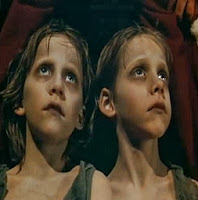Greetings, ladies and gents.
This is my first post with the Cult Significant, and to make up for totally missing Halloween due to teaching, grad school work, and a splitting headache, I've got something a little two-sided to bring to our table. Today, in honor of yesterday's Halloween and in preparation of next year's Halloween, I present to you terror and horror.
 |
| These are Want and Ignorance, but you get the idea. |
Let's recap:
The Oxford English Dictionary defines terror as "the state of being terrified or extremely frightened; intense fear or dread; an instance or feeling of this."
The OED also defines horror as "a painful emotion compounded of loathing and fear; a shuddering with terror and repugnance; strong aversion mingled with dread; the feeling excited by something shocking or frightful. Also in weaker sense, intense dislike or repugnance."
Okay, so what's the difference? In literature and film, terror is more about the atmosphere of the moment than it is about being confronted with "the thing" that is causing our fear. We feel terror as a result of not knowing what we will be confronted with. We feel terror when we tip-toe up to a ramshackle house in the middle of nowhere. We feel terror when the lights are out and the faint scratching of nails comes from behind the closet door. The darkness holds terror we cannot see. Horror, on the other hand, is about seeing the monstrosity presented before you in all its gore, deformity, or uncanniness (you know, doppelgangers or tulpas). Whether it's Frankenstein's creature, the ten-day-old corpse of your next-door neighbor, or the reflection in the mirror that isn't yours, these are all things that we actually see and that may actually scare the living shit out of us.
Why is the distinction important? Because in order to successfully create terror or horror in our audience, we have to know what they actually are, just like we can't cause happiness unless we know what things cause happiness. Case in point, Jack and his flopped attempt at making Christmas.
Sure, we can incite terror and horror in the same novel or film, but is it possible to do it at the same time? Not really. Terror requires tension; horror needs its images to be instant, thus causing the sudden surprise upon finding your rabbit boiled in a steaming pot of water. But can we have horror without terror? No. Terror always leads up to horror, whether it's within the film or book or before we encounter the horror within it.
Terror is what makes horror juicy. Terror is infinite; horror is exact. The number of "terrors" in our minds is countless; it could be this, it could be that, it could be that one thing, and/or it could be the other thing. With horror, however, there is only one thing: the thing that is there that we must see. Without terror, we become desensitized to horror, which has already begun to occur with films like the Saw and Hostel franchises that depend upon gratuitous violence and horror to make their viewers come back for more, but addiction to horror is another topic altogether.
Terror is hearing the boggart in the wardrobe; horror is seeing your worst fears manifested.
Even though "horror" films are advertised as such, are we really viewing horror films when we press "Play" on Netflix and a film like The House of the Devil begins streaming?
And, to send you off and initiate the transition from the terror and horror of the spooky season, here's Jose Gonzalez's cover of Massive Attack's "Teardrop."
Until next time,
Willa M Murray
Head Librarian